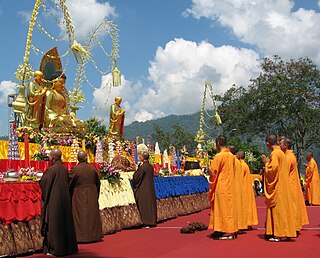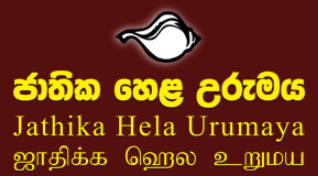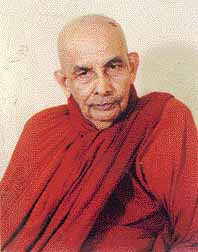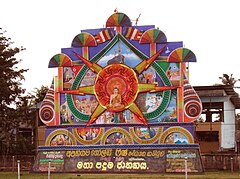
Vesak, also known as Buddha Jayanti, Buddha Purnima, and Buddha Day, is a holiday traditionally observed by Buddhists in South Asia and Southeast Asia, as well as Tibet and Mongolia. It is among the most important Buddhist festivals. The festival commemorates the birth, enlightenment (Nibbāna), and death (Parinirvāna) of Gautama Buddha in Theravada, Tibetan Buddhism and Navayana.

Mahinda was an Indian Buddhist monk depicted in Buddhist sources as bringing Buddhism to Sri Lanka. He was a Mauryan prince and the first-born son of Emperor Ashoka from his first wife and Empress Devi, and the older brother of Princess Sanghamitra.

Saṅghamittā was an Indian Buddhist nun and believed to be the eldest daughter of Emperor Ashoka and his first wife and Empress, Devi. Together with her brother Mahinda, she entered an order of Buddhist monks. The two siblings later went to Sri Lanka to spread the teachings of Buddha at the request of King Devanampiya Tissa who was a contemporary of Ashoka. Ashoka was initially reluctant to send his daughter on an overseas mission. However, because of the insistence of Sangamitra herself, he finally agreed. She was sent to Sri Lanka together with several other nuns to start the nun-lineage of Bhikkhunis at the request of King Tissa to ordain queen Anulā and other women of Tissa's court at Anuradhapura who desired to be ordained as nuns after Mahindra converted them to Buddhism.

Theravada Buddhism is the largest and official religion of Sri Lanka, practiced by 70.2% of the population as of 2012. Practitioners of Sri Lankan Buddhism can be found amongst the majority Sinhalese population as well as among the minority ethnic groups. Sri Lankan Buddhists share many similarities with Southeast Asian Buddhists, specifically Myanmar Buddhists and Thai Buddhists due to traditional and cultural exchange. Sri Lanka is one of five nations with a Theravada Buddhist majority.

Jaya Sri Maha Bodhi is a historical sacred bo tree in the Mahamewuna Garden in historical city of Anuradhapura, Sri Lanka. This is believed to be a tree grown from a cutting of the southern branch from the historical sacred bo tree, Sri Maha Bodhi, which was destroyed during the time of Emperor Ashoka the Great, at Buddha Gaya in India, under which Siddhartha Gautama (Buddha) attained Enlightenment. The Buddhist nun Sangamitta Maha Theri, a daughter of Indian Emperor Ashoka, in 236 BC, brought the tree cutting to Sri Lanka during the reign of Sinhalese King Devanampiya Tissa.[1] At more than 2,300 years old, it is the oldest living human-planted tree in the world with a known planting date. The Mahavamsa, or the great chronicle of the Sinhalese, provides an elaborate account of the establishment of the Jaya Siri Maha Bodhi on the Island and the subsequent development of the site as a major Buddhist pilgrimage site.

The Jathika Hela Urumaya, less commonly known by its English name the National Heritage Party, is a Sinhala Buddhist nationalist political party in Sri Lanka. The JHU was launched in February 2004 by the lay-based, Sinhalese nationalist political party Sihala Urumaya.
Poya is the name given to the Lunar monthly Buddhist holiday of Uposatha in Sri Lanka, where it is a civil and bank holiday. When earth makes Full Orbit of moon is normally considered as the poya day in Sri Lanka every month.

Mihintale is a mountain peak near Anuradhapura in Sri Lanka. It is believed by Sri Lankans to be the site of a meeting between the Buddhist monk Mahinda and King Devanampiyatissa which inaugurated the presence of Buddhism in Sri Lanka. It is now a pilgrimage site, and the site of several religious monuments and abandoned structures.

Tissa, later Devanampiya Tissa, meaning, was one of the earliest kings of Sri Lanka based at the ancient capital of Anuradhapura. According to the traditional chronology, he ruled from 307 BC to 267 BC, but the modified chronology adopted by modern scholars such as Wilhelm Geiger assigns his reign to 247 BC to 207 BC. His reign was notable for the arrival of Buddhism in Sri Lanka under the aegis of the Mauryan Emperor Ashoka the Great. The primary source for his reign is the Mahavamsa, which in turn is based on the more ancient Dipavamsa.

The Tissamaharama Raja Maha Vihara is an ancient Buddhist temple in Tissamaharama, Southern Province of Sri Lanka. It was one of the four major Buddhist monasteries established in Sri Lanka, after the arrival of Arhant Mahinda Thera to the country. The site of the Tissamaharama Raja Maha Vihara was consecrated by Buddha himself, who spent some time in meditation there with 500 arhats, during his third visit to the island. Tissamaharama monastery had been recognized as a pre-eminent Buddhist educational center of the southern Sri Lanka from the 3rd century B.C. to the 11th century A.D. The Tissamaharama Dagoba which is situated in the premises of the monastery is one of the largest stupas in Sri Lanka. The present chief incumbent of Tissamaharama Raja Maha Vihara is Ven. Devalegama Dhammasena Nayaka Thera.

Stupas, also called dagebas and cetiyas, are considered an outstanding type of architectural creation of ancient Sri Lanka. Under the influence of Buddhism, there were several changes in the field of architecture in Sri Lanka. The stupa commands a prominent place among these changes. The Stupa is also known by synonymous names such as Chaithya, Dagaba, Thupa, Seya and Vehera. Stupas designed and constructed in Sri Lanka are the largest brick structures known to the pre-modern world.
An Uposatha day is a Buddhist day of observance, in existence since the Buddha's time, and still being kept today by Buddhist practitioners. The Buddha taught that the Uposatha day is for "the cleansing of the defiled mind," resulting in inner calm and joy. On this day, both lay and ordained members of the sangha intensify their practice, deepen their knowledge and express communal commitment through millennia-old acts of lay-monastic reciprocity. On these days, the lay followers make a conscious effort to keep the Five Precepts or the ten precepts. It is a day for practicing the Buddha's teachings and meditation.
Sri Lanka, having a history as long as many ancient civilizations, positioned at the crossroads of the East and the West, and being a multicultural society, celebrates a wide variety of festivals, ceremonies and events.
This is a list of holidays celebrated within the Buddhist tradition.

Most Venerable Madihe Pannaseeha Mahathera was an eminent Sri Lankan Buddhist monk, who was the Mahanayaka of Amarapura sect from July 13, 1969, until his death on September 9, 2003.

Kataragama deviyo is a guardian deity of Sri Lanka. A popular deity who is considered to be very powerful, shrines dedicated to Kataragama deviyo are found in many places of the country. Sinhalese Buddhists believe him also as a divine patron of the Buddha Sasana in Sri Lanka. An ancient temple dedicated to God Kataragama, known as Ruhunu Maha Kataragama Devalaya is situated in the South-Eastern town of Kataragama in Monaragala District of Uva Province.
The Port of Jambukolapattinam or Dambakola Patuna is an ancient port to the north of Jaffna, in the Northern Province, Sri Lanka.
Rajagala, commonly Rassaagala or Rajagalathenna, is a rugged and heavily forested mountain situated 1,038 feet (316 m) above sea level, in a sparsely populated part of Eastern Province, Sri Lanka which has an important archaeological value. The Rajagala archaeological site is only second to the Mihintale monastery in Anuradhapura and it spreads over 1,600 acres. It consists more than 600 prehistoric ruins, monuments and artifacts, and nearly 100 of them are ancient stupas.

Weliwita Asaranasarana Sri Saranankara Sangharaja Thero or popularly Weliwita Sri Saranankara Thero was a Buddhist monk, who was the last Sangharaja of Sri Lanka. He was the pioneer in the revival of Buddhism in Sri Lanka, after the decline of the religion in the 17th and 18th centuries. Saranankara Thero was bestowed with the a title by king Kirthi Sri Rajasinghe in 1753, the same year he received the Upasampada and re-established the Upasampada in Sri Lanka with the help of Mahasangha in Siam. He is also credited with the establishment of Silvath Samagama, a union of monks who lived in accordance with the Buddhist monastic discipline.
Mihintale line is a 5 ft 6 in gauge railway line in Sri Lanka which starts from Anuradhapura and ends at Mihintale, which was constructed in 1993.













